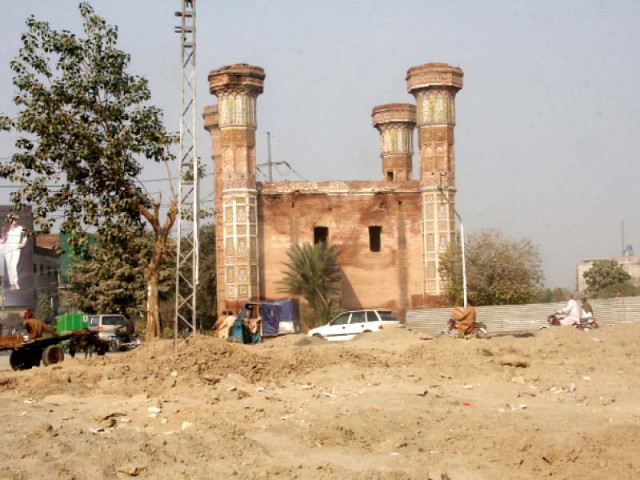Orange Line makes conservationists see red
Archaeology Department says that it violates the Antiquities Act in at least six locations

Archaeology Department says that it violates the Antiquities Act in at least six locations.
The controversy over whether the construction of the 27-km Orange Line will damage historical sites located on it course sparked outrage among members of the civil society this year.
According to Archaeology Department Deputy Director Afzal Khan, it violates the Antiquities Act in at least six locations as construction near these sites will take place within the 200ft boundary limit set by the Act.
One of these sites is the Chaubaurji monument, which was the gateway to the garden of Zebunnisa, the daughter of Emperor Aurangzeb. The Lahore Conservation Society, which has been protesting against the construction, says that work on the Orange Line is being carried out within 40 feet away of the monument.
Raheem ul Haque, a research fellow at FC College’s Centre for Public Policy and Governance, who has been looking into the impact of such development projects, says it is important to look at the amount of money going into it. The cost of land acquisition has not been added to the cost presented to the public.
“A lot people believe that we are romanticising buildings and sites while, in fact, we are talking about an entire culture and lifestyle which the train will disrupt,” he says.
Almost 350 families will be displaced from Kapurthala House alone, he says. He says while larger monuments have gained public attention, there are smaller ones like the Mauj Darya shrine which have been ignored. He says the government should make details of the plan public so that people have more information about the train, and the research that has gone into planning it.
“There seems to be no proper collection of on-ground data collected for the EIA,” he says.
Citing a two-year study conducted by Systra, an international engineering and consulting group, he says the study had advised that the 7km section from Chaubaurji to Sultanpura should be kept underground. Imrana Tiwana of the Lahore Conservation Society says the Blue and Purple Lines will also pass though the city centre. “These will go from Data Darbar to the airport via The Mall at a height of 40 feet and Jail Road-Main Gulberg Boulevard. Over 400 acres of land will be acquired for this purpose.”
The character, ethos and spirit of Lahore will die a very rapid death if this is allowed to go ahead as planned, she says.
Tiwana says in all other countries where pressing development needs demand public transport and mobility, most trains are underground in sensitive areas. Delhi, she says, is a close example.
“Lahore is a living museum… one has to be very sensitive in planning, expanding and making development interventions to the city. Lahore is a mega city with over 11 million people. We are in grave danger of losing our tangible and intangible as well as natural and built heritage,” she says.
The Orange Line starts in the east of Lahore from the main depot in Dera Gujjar, along GT Road to the City Railway Station, across the city centre through Lakshami Chowk, McLoed Road and Lake Road to Chauburji before heading southwest via Multan Road and Raiwind Road, to a stabling yard and terminus in Ali Town.
Published in The Express Tribune, December 31st, 2015.



















COMMENTS
Comments are moderated and generally will be posted if they are on-topic and not abusive.
For more information, please see our Comments FAQ